Key takeaways:
- Swift generics enhance code versatility, reusability, and type safety, reducing redundancy and improving clarity.
- Utilizing protocols with generics allows for type constraints, ensuring safer and more organized code.
- Advanced techniques like associated types and higher-order functions enable greater flexibility and a more declarative coding style.
- Common pitfalls include overusing constraints, misunderstanding type inference, and complications with protocol composition, highlighting the importance of balance and clarity in coding practices.
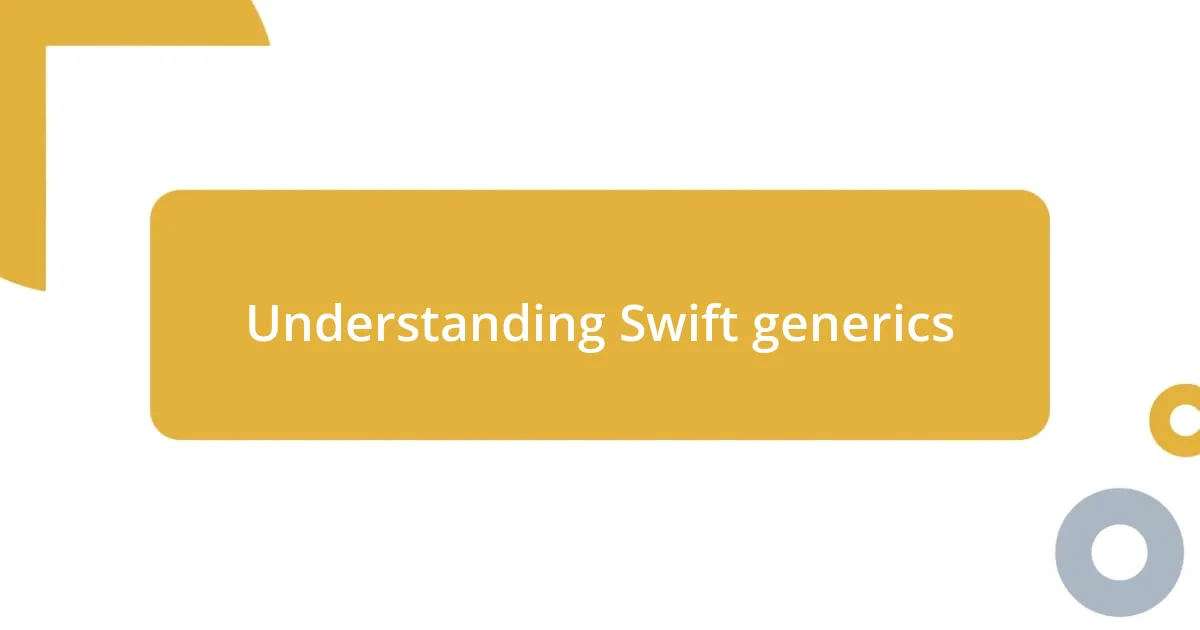
Understanding Swift generics
Swift generics are like a secret ingredient that can enhance your code, making it versatile and reusable. I remember the first time I stumbled upon generics in a project; it felt like I had found a powerful tool that simplified my functions without sacrificing type safety. Why limit yourself to a specific type when you can create methods that work with many types?
When I started using generics, I quickly realized how they reduce code duplication. For example, I once had to write different functions for sorting arrays of integers and strings. Once I embraced generics, I could write a single, efficient function that worked for both, making my code cleaner and easier to maintain. Isn’t it fascinating how a few concepts can transform your approach to programming?
One key aspect of Swift generics is type constraints. This feature allows you to specify that a generic type must conform to a particular protocol. I found this especially useful when I was developing a custom collection type; it enforced a level of safety and consistency in my code. It’s amazing how these seemingly small details can lead to robust and adaptable code structures. Don’t you think that elevating your code’s quality is a rewarding journey?
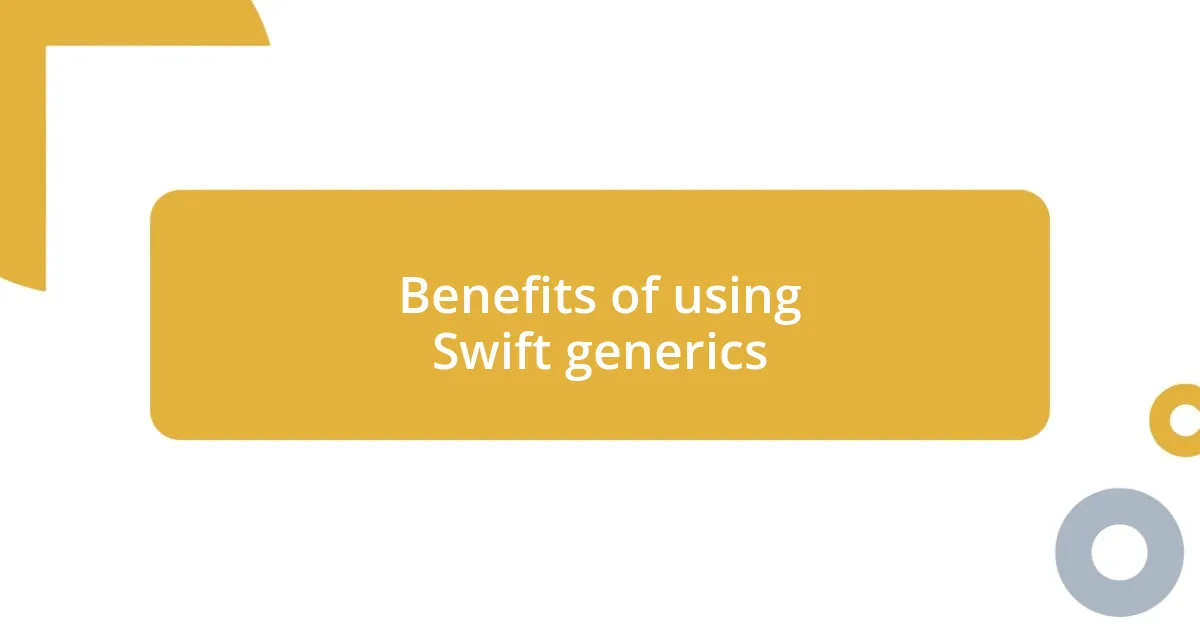
Benefits of using Swift generics
Using Swift generics truly opens up a world of flexibility in programming. I recall a time when I was developing a feature for an app that involved different data types: integers, strings, and even custom objects. Thanks to generics, I created a single function that managed all of them seamlessly. This not only made my codebase lighter and easier to navigate but allowed me to focus on building features instead of getting bogged down in repetitive code.
Here are some benefits of using Swift generics:
- Code Reusability: One function can serve multiple types, reducing redundancy.
- Type Safety: Generics allow for safer code, catching errors at compile time rather than runtime.
- Flexibility: You can create functions and data types that adapt to different types without losing functionality.
- Clarity: By removing repetitive code, your logic becomes clearer and easier to understand for other developers (and your future self!).
- Performance: Generics can lead to more optimized code since the compiler can make assumptions about the types being used.
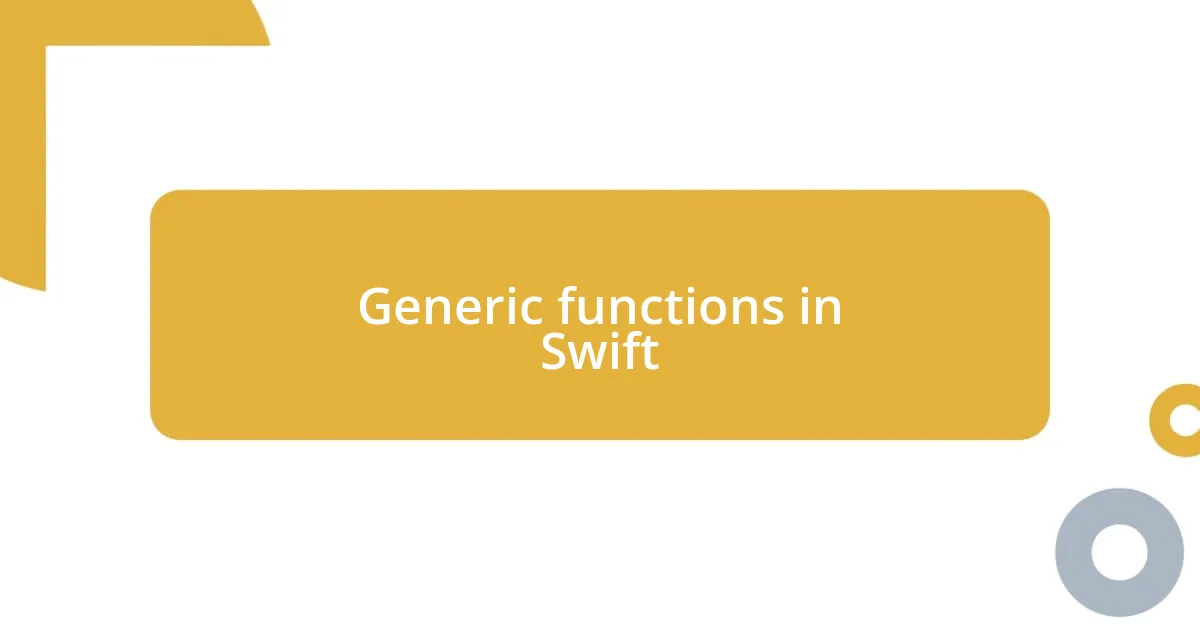
Generic functions in Swift
Generic functions in Swift allow developers to define methods that can operate on any type, enhancing both flexibility and maintainability. I remember tweaking a function that calculated the maximum value in an array; I realized I could apply it to any data type by just using generics. Instantly, I felt this sense of empowerment, knowing that I wasn’t confined to just a narrow set of parameters — it truly broadened the horizon for my coding possibilities.
When I first implemented a generic function, I was impressed by how easily I could handle multiple types while maintaining clarity in my code. Using a generic type <T> meant I could write one method that worked seamlessly with both integers and floats without creating numerous overloads. It was like finding a shortcut that actually wrote itself while ensuring it remained robust. Can you envision how much easier problem-solving can be with such tools at your disposal?
In Swift, creating a generic function is straightforward. For instance, when I wrote a function to compare two values, the syntax was simple yet powerful. I recall the moment I realized I could eliminate redundancy from my code while retaining the functionality I needed. The clarity it brought to my projects was significant — it felt like a breath of fresh air. Rather than juggling multiple functions, I could focus on enhancing my app’s features, knowing my generic function had it all covered.
| Aspect | Explanation |
|---|---|
| Generics | Functions designed to work with any data type, enhancing flexibility. |
| Type Parameter | Placeholder that allows a function to accept any type (e.g., |
| Code Efficiency | Reduces redundant code, keeping the codebase clean and easier to manage. |
| Type Constraints | Enforce certain conditions on the types used in a generic function. |
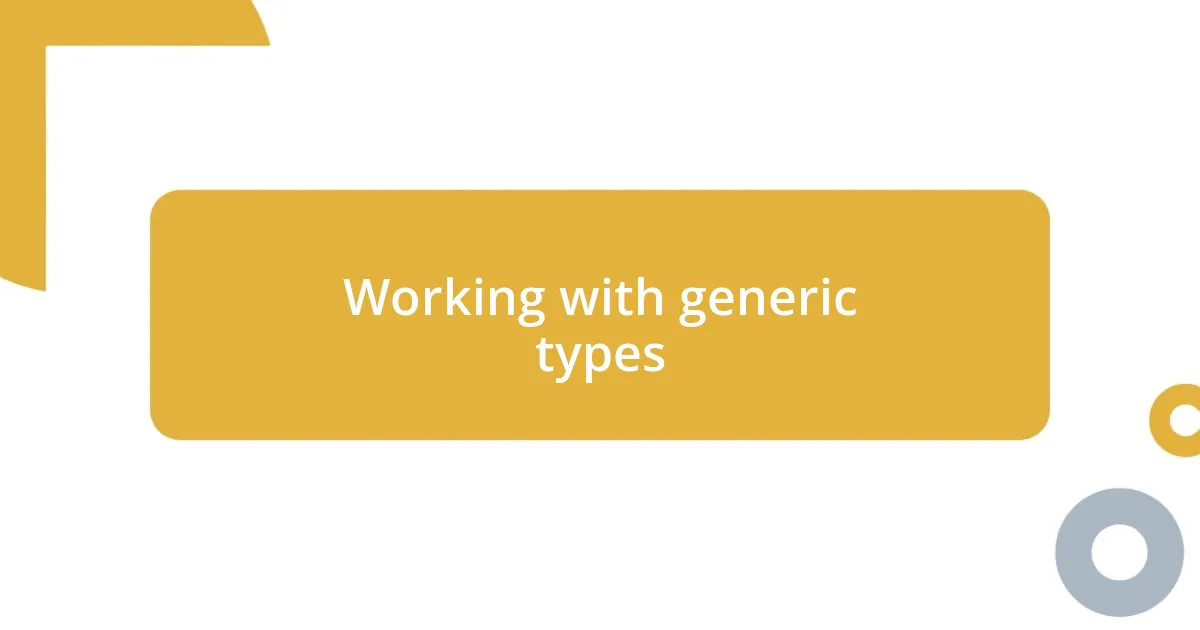
Working with generic types
Working with generic types in Swift gives you a remarkable advantage in creating robust and reusable components. I distinctly remember the first time I needed to sort an array of different types. By employing a generic type <Element>, I felt a rush of excitement as I realized that sort algorithms could operate seamlessly across various data types. It was like tuning a finely crafted instrument — suddenly everything harmonized perfectly without the clutter of type-specific code.
In one project, I used type constraints to limit the flexibility of my generics to only types conforming to a protocol. This added a layer of safety and clarity that I hadn’t anticipated. By ensuring that the function only accepted parameters adhering to the protocol’s requirements, I noticed a significant reduction in runtime errors. It felt reassuring to watch the compiler catch potential issues early on. Have you ever had that moment where the tool you’re using feels like it has your back, almost like a safety net? That’s how I felt, empowered to explore without fear of breaking things.
Every time I implement generics, it’s a reminder of how far Swift has come in making complex coding tasks simpler. Just the other day, I was refactoring a piece of legacy code that had myriad type-specific functions. Converting them to generics not only cut down my workload but also made the code remarkably clearer. It was less about how many functions I could write and more about how elegantly I could solve a problem. Isn’t that what we all strive for — effective solutions that actually elevate our coding experience?
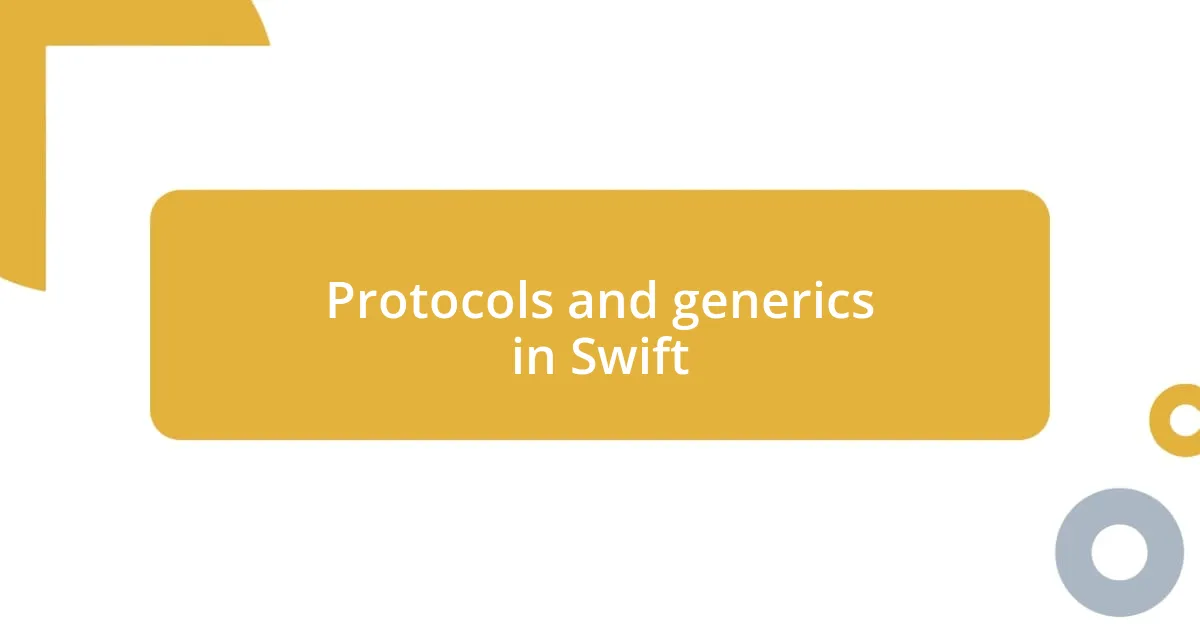
Protocols and generics in Swift
Protocols and generics in Swift work hand in hand to create highly reusable and type-safe code. I can recall the first time I used a protocol with a generic type; it felt like a light bulb moment. Suddenly, my functions could be constrained to only accept types that fit certain criteria, ensuring that I didn’t accidentally pass in something that would blow up at runtime. Isn’t it thrilling to see how combining these two features can elevate the integrity of your code?
I once developed a networking layer where I needed to ensure that any returned object adhered to a specific interface. Using a protocol with generics allowed me to define expectations without being tied to one concrete type. I remember how relieved I was when I saw how easily I could swap out different data models while keeping the same underlying logic intact. Have you ever experienced that delightful moment when your code just works seamlessly because of the solid structure provided by protocols and generics?
Moreover, the beauty of using protocols alongside generics lies in the clarity they bring to your codebase. When I shifted some of my earlier implementations to this approach, I felt as if I was given a new lens through which to view my projects. The ability to define interface requirements while maintaining the flexibility of generics makes it easier for me to understand relationships between different types. It’s akin to having a well-organized toolbox — everything in its place, ready for use whenever creativity strikes!
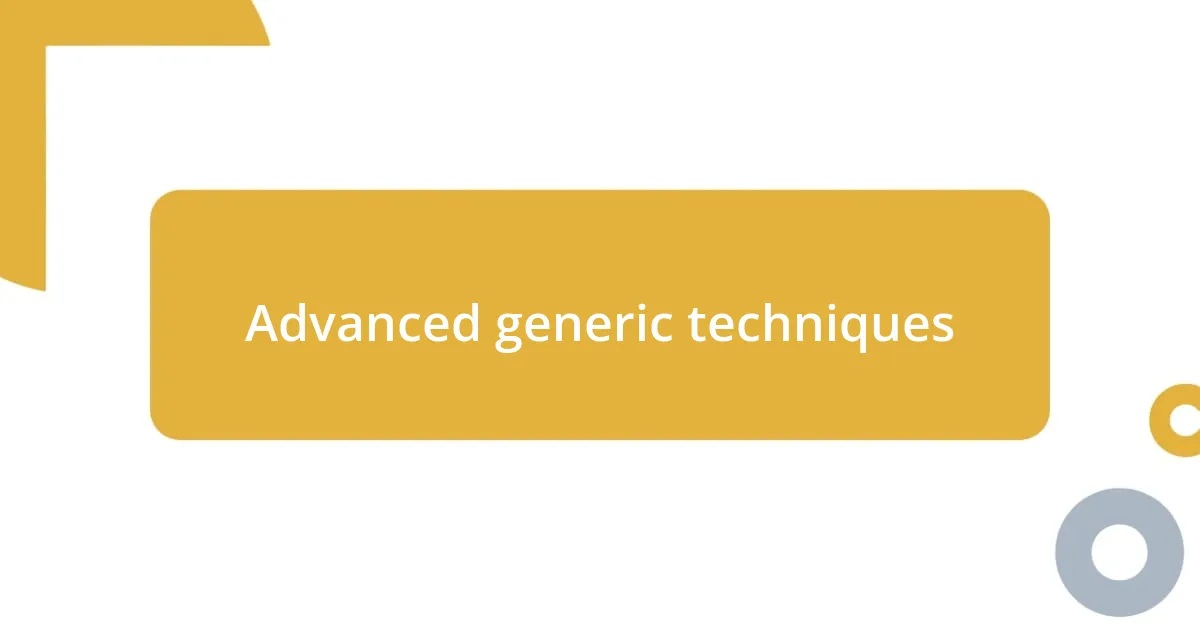
Advanced generic techniques
Advanced generic techniques can significantly enhance the way we structure our code in Swift. One technique I’ve found particularly empowering is the use of associated types within protocols. When I first encountered this feature, it was like discovering a hidden gem. It lets you define a placeholder type that conforms to a protocol, providing even greater flexibility. Suddenly, I was able to create a protocol for a data source without strictly binding it to a specific type, which made my codebase feel much more dynamic. Have you ever experienced the thrill of writing a piece of code that feels almost alive because of its flexibility?
Another advanced technique involves leveraging higher-order functions with generics. I remember introducing methods like map, filter, and reduce into my projects involving custom collection types. This fusion of generics with functional programming principles took my coding to another level. It opened the door to a more declarative style, allowing me to describe what I wanted to achieve rather than focusing solely on how to implement it. It often made me stop and wonder — could code be this elegant and expressive at the same time? Yes, and it was a revelation!
Lastly, using generic types with constraints effectively can be a game-changer when dealing with complex algorithms. I once worked on a graphics processing app where I had to ensure that various operations only accepted specific numeric types. I employed generic constraints to limit the types to FloatingPoint and Comparable. The resulting code had a crispness to it that made me feel accomplished. Isn’t it gratifying when your code not only works but also reads like poetry? It makes complex systems feel simpler and more manageable, and that’s something I always strive for.
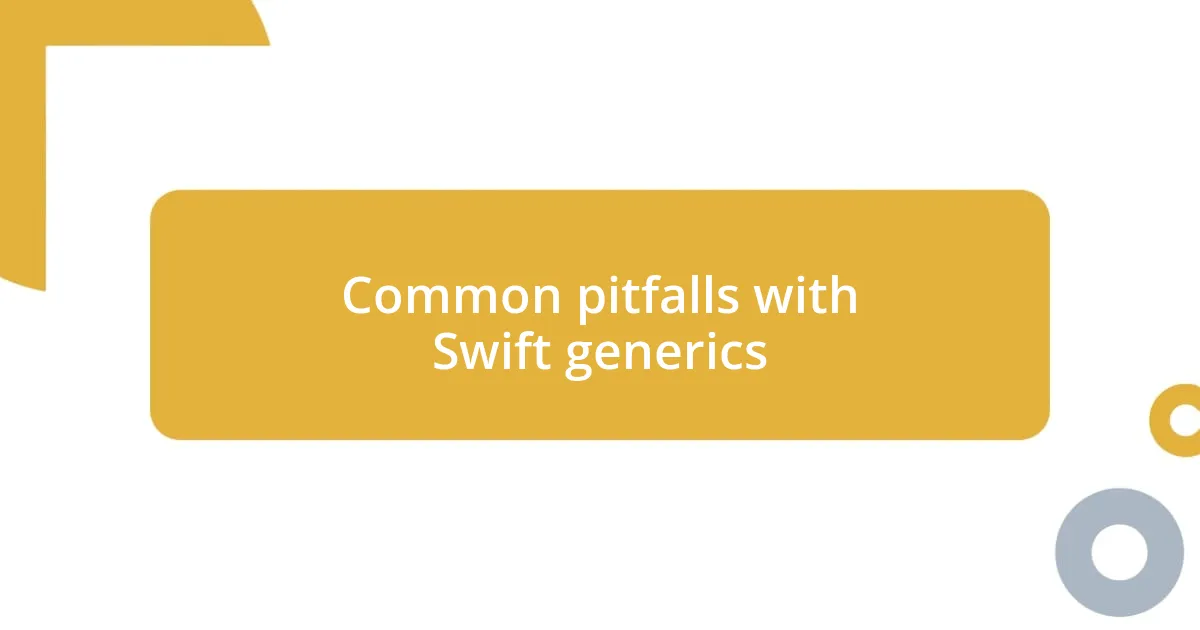
Common pitfalls with Swift generics
When working with Swift generics, one common pitfall I’ve encountered is the overuse of constraints. I recall a project where I became so obsessed with making my code ultra-restrictive that I ended up limiting the usability of my generic types. It felt frustrating to peel back my constraints later and realize I’d boxed myself into a corner. Have you ever found your code more rigid than intended? It can happen to the best of us when we mix good intentions with over-engineering.
Another challenge presents itself with the concept of type inference. Early in my experience with generics, I’d often misjudged how types would be inferred in a complex function signature. I remember looking at a compiler error that felt like a puzzle I couldn’t solve for hours. It turns out that not being explicit with my types led me astray. Do you ever feel stuck in those moments? It’s crucial to remember that being explicit can save a great deal of time and headaches down the line.
Lastly, I’ve often seen Swift developers trip over the limitations of protocol composition. In one instance, I tried to combine multiple protocols to create a type but was stumped when the compiler rejected my definition. It felt like hitting a wall. This experience taught me that while Swift provides powerful features, there are boundaries to what you can achieve with protocol and generic combinations. It’s essential to embrace these limitations and find creative workarounds. Isn’t it fascinating how refining your approach can often spark new ideas?














